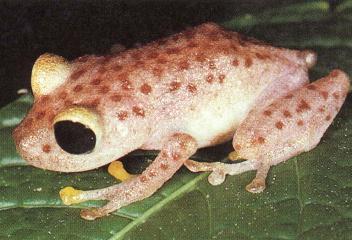


|
Leptodactylidae :
A large and diverse group of 7 subfamilies, 50 genera and over 1100 species, all of which occur in the new world. It contains the largest vertebrate genus, Eleutherodactylus, with over 700 species. Greatest diversity occurs in Central and South America as well as the Caribbean. Frogs of the genus Eleutherodactylus are small and collectively known as the rain frogs. The most famous of these frogs are the E. coqui and E. johnstoni due to their loud calls, high densities, and ability to populate anywhere they are introduced. Telmatobius culeus, the Lake Titicaca frog, lives at a high elevation in Peru and has taken on a wrinkled appearance due to extra skin for increased surface area, in order to be more efficient in an oxygen poor environment. Ceratophorid frogs also belong to this group; they are sit and wait predators with voracious appetites. This family has no known morphological synapomorphies.
Genus :
Adelophryne (5 species)
Adenomera (9 species)
Alsodes (16 species)
Atelognathus (9 species)
Atopophrynus (1 species)
Barycholos (2 species)
Batrachophrynus (2 species)
Batrachyla (5 species)
Caudiverbera (1 species)
Ceratophrys (8 species)
Chacophrys (1 species)
Craugastor (119 species) |
